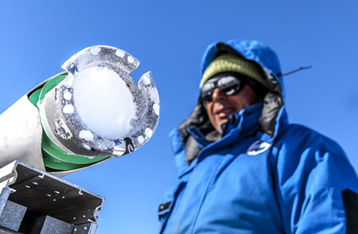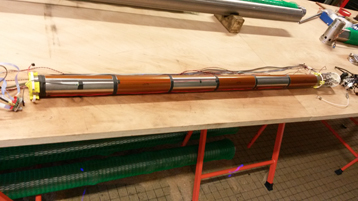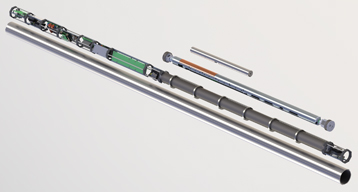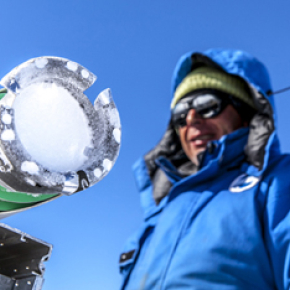
Searching for the world's oldest ice
Why did the rhythm of glaciations suddenly slow down about a million years ago? To answer this question and to better forecast future climate change, a consortium of researchers from 14 institutions1 , including France's CNRS and IPEV, have set out to find ice that is at least 1.5 million years old. With €2.2 million funding over three years under the European Horizon 2020 program, this project aims to locate a site in Antarctica that would date back to more than 800,000 years, the maximum age of the ice extracted during the EPICA drilling carried out at Dome C. The studies will begin this year during the austral summer in two regions of Antarctica: one close to the Fuji dome and the other near the Concordia station. The French teams will test a new probe that dates the ice in real time, without the need for coring.
- 1The members of the BE–OI consortium (14 institutions from 10 European countries): Alfred Wegener Institute - Helmholtz Centre for Polar and Marine Research (AWI, Germany) – project coordinator –, Institut Polaire Français Paul Émile Victor (IPEV, France), Agenzia nazionale per le nuove tecnologie, l'energia e lo sviluppo economico sostenibile (ENEA, Italy), Centre National de la Recherche Scientifique (CNRS, France), Natural Environment Research Council – British Antarctic Survey (NERC-BAS, Great Britain), Universiteit Utrecht – Institute for Marine and Atmospheric Research (UU-IMAU, Netherlands), Norwegian Polar Institute (NPI, Norway), Stockholms Universitet (SU, Sweden), Universität Bern (UBERN, Switzerland), Università di Bologna (UNIBO, Italy), University of Cambridge (UCAM, Great Britain), Kobenhavns Universitet (UCPH, Denmark), Université Libre de Bruxelles (ULB, Belgium), Lunds Universitet (ULUND, Sweden).
The aim of the Beyond EPICA – Oldest Ice (BE-OI) project is to find Antarctic ice that is at least 1.5 million years old. Coordinated by the Alfred Wegener Institute in Germany, it involves both the CNRS and IPEV. Extracting a core of such old ice would solve one of the mysteries of paleoclimatology. Indeed, about a million years ago, the climate of the Earth underwent a major change in rhythm. "Today, we still do not know why the periodicity of glacial–interglacial cycles changed considerably around 900,000 to 1,200,000 years B.C.", explains Jérôme Chappellaz, CNRS senior researcher and representative within the BE-OI consortium and leader of one of its working groups. While glaciations had been occurring every 40,000 years or so, marine sediments show that their frequency then decreased to once every 100,000 years. But how this change took place and the reasons behind it are still a mystery, and will remain so unless scientists manage to obtain ice dating from the relevant period.
Using ice cores, scientists can collect a wealth of data on the functioning of the Earth's climate system, including the evolution of greenhouse gases in the atmosphere. Only these glacial archives can provide direct information on the composition of the atmosphere in the past and make it possible to assess the role played by greenhouse gases during this major climate transition. To achieve this goal, the BE-OI project will employ a set of original methods to determine the location of this coveted ice, such as geophysical measurements and specific dating techniques. It will also use technologies allowing fast access to deep ice, such as Subglacior, a probe that dates the ice in real time, and which has been developed by several CNRS-affiliated laboratories2
. Two potentially interesting regions of Antarctica will be explored: the Fuji Dome Sector and an area called "Little Dome C" located about 40 kilometers from Concordia.
In the austral summer of 2016/2017, the German team will deploy an airborne radar in the Fuji Dome area with the aim of documenting the internal layers of the glacier, characterizing the profile of the bedrock, determining the physical properties of the ice, and checking whether abnormal flows could have mixed the ancient layers. The Italian and British teams will carry out radar measurements near Concordia, with the same objective.
As for the French group, the first tests of the Subglacior probe in Antarctica will also be carried out during the austral summer season 2016/2017. This entirely new and innovative probe will make it possible to measure certain geochemical signals within the glacier itself, continuously and in real time, making it possible to evaluate the age of the ice and the glacier's stratigraphic continuity. An undeniable advantage of the probe is that this information can be obtained without coring. "Everything in this probe is new, from the embedded laser instrument to the way in which we penetrate the glacier," says Jerome Chappellaz, who will perform the testing with eight other project members. It will be deployed the following season near Concordia on the site considered the most promising by the BE-OI consortium (based on the geophysical data obtained this year).
The CNRS participates in the project not only through the deployment of Subglacior but also by contributing its expertise in the modeling of glacial flow and radiochronological dating. While the geophysical data are collected by international partners, CNRS researchers are strongly involved in their interpretation. "We have developed powerful modeling tools to interpret radar echoes, assess the flow of the glacier over time, and date the deep layers," explains Catherine Ritz, CNRS senior researcher and leader of this project within the BE-OI consortium. In addition, two researchers from the CEREGE (CNRS / AMU / IRD / Collège de France) will use rapid recognition tools to study the ice chips brought up from great depths, in order to validate the ages estimated by the other instruments.
The European financial contribution will mostly be used to support complex and costly logistics in Antarctica. Thus, the Institut Polaire Français, with its Italian partner PNRA, makes an essential contribution to these logistics by implementing the program and hosting scientists using its own resources and personnel. The two institutes operate the French-Italian station Concordia, a test site for the probe but also a starting point for promising sites located at "Little Dome C". The two institutes will set up specific means to create two remote camps so that researchers can study these sites for more than two months without having the usual infrastructure of a scientific station.
Finally, the project also aims to put in place the necessary expertise for future deep drilling (by improving current drilling technologies), as well as the scientific management and financing plan for this next stage of the consortium.
Beyond the European BE-OI consortium, this quest for the oldest ice on Earth is the subject of international commitment: US, Chinese, Japanese, Russian and Australian teams are also engaged in this effort, and rely on their own logistic resources in Antarctica. At the international level, these studies are coordinated by the "International Partnerships in Ice Core Sciences" program.

Sampling of an ice core during the testing of the prototype of the Mini-Subglacior experimental probe on the Concordia station in Antarctica. Within a single field season (2 to 3 months), the Subglacior probe will make it possible to explore the ice up to 3 km deep to obtain climatic recordings of the last 1.5 million years, the oldest data obtained from natural ice.

First test of the prototype of the Mini-Subglacior experimental probe on the Concordia base in Antarctica. The engineers are checking that the ice chips rise to the surface correctly.

The OF-CEAS laser spectrometer embedded inside the probe. The instrument itself is only 40 mm in diameter. It is inserted here in a vacuum pressure tube with a diameter of 50 mm.

A SolidWorks diagram of the laser instrument, with its electronics, embedded in the Subglacior probe. Like a Russian doll (each element is inserted into the next larger), the devices comprises, from top to bottom, the optical instrument itself (40 mm diameter), the support tube of the spectrometer kept under vacuum (50 mm diameter), the spectrometer + electronics assembly held in a diameter of 82 mm, the pressure tube encompassing the assembly with a diameter of 100 mm. The instrumental ensemble is approximately 3 meters long and is installed within the probe whose total length is 12 meters.
Other images are available upon request.
BE-OI, or "Beyond EPICA – Oldest Ice"
In Antarctica internationally leading ice and climate scientists are looking for the oldest ice-core record on Earth. They want to find the place, where in Antarctica the ice core can be drilled which goes furthest back in Earth's history, up to 1.5 million years. Such a core would allow to deciphering past processes in the climate system to improve prognoses for the future. "Beyond EPICA - Oldest Ice" has received funding from the European Union's Horizon 2020 research and innovation programme under grant agreement No 730258 with. The project runs from October 2016 to September 2019 and brings together experts of 14 institutions from ten European countries, coordinated by the German Alfred Wegener Institute Helmholtz Centre for Polar and Marine Research.
- 2The teams LGGE (CNRS/Université de Grenoble Alpes), LIPhy (CNRS/Université de Grenoble Alpes), LSCE (CNRS/CEA/UVSQ) and the technical division of INSU-CNRS all participated in its development.


